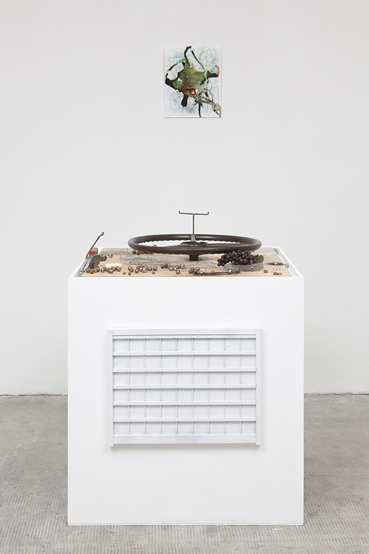
© » KADIST
Adrian Villar Rojas
The two drawings in the Kadist Collection are part of a larger series entitled Las Mariposas Eternas (The Eternal Butterflies). They are studies for two large sculptures that explore the role of monuments and emblems in the configuration of Latin American national identities. The first drawing reproduces an equestrian statue of Juan Lavalle, one of Argentina’s independence heroes.

© » KADIST
Adrian Villar Rojas
Drawing & Print (Drawing & Print)
Based on historical prophecies and fantasy, the artist creates apocalyptic scenarios that posit an enigmatic world plagued by social, political, and environmental upheaval. Untitled (Set of Six Drawings) (2012) is an intricate watercolor of a child sitting cross-legged with its head stuck inside a giant mask resembling a duck head covered with eyes. It looks like a scene snatched from science fiction or a surreal dream; it is tempting to see in it some kind of warning sign, or an ominous vision of the future.

© » KADIST
Clare Rojas
Rojas’s two pieces in the Kadist Collection— Untitled (four-legged…) and Untitled (Bird’s Eyes) —are representative of her pictorial style which uses bold colorful blocks of paint and female and animal characters. While Untitled (Bird’s Eyes) does not depict any actual women, it nevertheless alludes to gender roles and the power of the female gaze. Apparently playful, this scene of two animals has an ominous quality: A bird and a hedgehog confront at each other and the bird appears to be poking, even eating the hedgehog’s eye.

© » KADIST
Adrien Missika
Adrien Missika follows in the footsteps of the Brazilian landscape architect and artist Roberto Burle Marx (1909-1994), a designer of gardens, parks and promenades who introduced modern landscape architecture to Brazil. Marx’s work is characterized by the use of native tropical vegetation as a structural element of design. He worked with Oscar Niemeyer and Lucio Costa, the architects of Brazilia, and with them, the tropical plant became a motif in urban architecture.

© » KADIST
Adriana Martínez
Her 2015 work Orión is a black flag-like cloth with glow-in-the-dark symbols embroidered in the shape of the constellation. In the place of stars, Martínez has substituted the logos of international corporations and entities that use stars as their symbol; celestial navigation commanded by the logic of international corporations. Easily spotted is the smiling face of the Carl’s Jr. / Hardee’s logo, the three-pronged Mercedes-Benz emblem, Walmart’s six-pointed asterisk, and the starry cluster of the Subaru shield.

© » KADIST
Adriana Bustos
El mar y sus múltiples afluentes (The Sea and its Multiple Tributaries) builds on the concept of trafficking that Adriana Bustos has been exploring over the last decade. The piece represents an apocryphal river and illustrates the routes of the slave trade between the coasts of Africa, Europe, and South America, departing from the Congo River (once called Zaira), and arriving at Río de la Plata, the main river in Buenos Aires that divides Argentina from Uruguay. The work collapses time and space, placing the coasts of colonial empires across the colonies where slaves were taken.

© » KADIST
Adriano Costa
Westminster Agua Viva is made from Westminster City Council(‘s) recycling bin bags, glued together, that the artist has painted and cut or cut and painted. Although, they hang on the wall they possess a strong sculptural quality as the fringes float away from the wall. This is part of a series of works that refer to Brazilian concrete and neo-concrete art as well as Arte Povera in a playful manner while demonstrating a strong identity of its own.
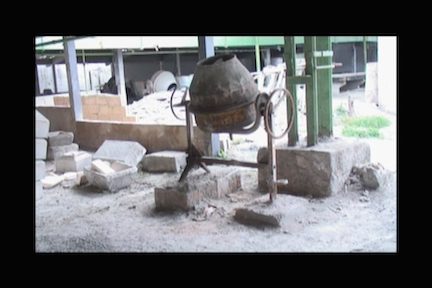
© » KADIST
Adrian Melis Sosa
In Cuba, due to the lack of materials, workers of state-owned construction companies must remain at work without doing anything, waiting for the end of the working day. Interested in this phenomenon, Adrian Melis asked the workers of a construction company to reproduce the sounds and noises characteristic of their work. The making of forty rectangular pieces for a floor construction is the recording of a “work performance” during a day from eight in the morning to five in the afternoon.

© » KADIST
Miguel Angel Rojas
Drawing & Print (Drawing & Print)
In his paper-based work, Medellin-New York , Rojas uses coca leaves and dollar bills to spell out the words of the two cities, tied together through the illicit exchange of materials used to make the word, gesturing towards the uncomfortable reality of the drug trafficking trade and the complicity of both America and Colombia within that economic system.

© » KADIST
Clare Rojas
Rojas’s two pieces in the Kadist Collection— Untitled (four-legged…) and Untitled (Bird’s Eyes) —are representative of her pictorial style which uses bold colorful blocks of paint and female and animal characters. While Untitled (Bird’s Eyes) does not depict any actual women, it nevertheless alludes to gender roles and the power of the female gaze. Apparently playful, this scene of two animals has an ominous quality: A bird and a hedgehog confront at each other and the bird appears to be poking, even eating the hedgehog’s eye.

© » KADIST
Adrían Balseca
Adrian Balseca’s Suspensión I inverts the logic of the old colonial game, the greasy pole. Digitally filmed in the Province of Morona Santiago among the last existing community at the entrance of the Sangay National Park, a native girl climbs a balsa tree trunk from which plastic containers filled with “local” fossil fuels hang (super, extra, eco-país, gasoline, diesel, etc.). The trunk – which is lightweight quality wood, typical of the subtropical jungle of Ecuador -– has been cut down and suspended vertically and the trophies of modern progress hang from it.

© » KADIST
Adrían Balseca
The project Grabador Fantasma (Phantom Recorder) consists of a communally constructed technological device in Sarayaku ancestral territory. Adrian Balseca’s site-specific composition is an “ecología del paisaje sonoro”, an artifact that collects sounds produced by different organisms, amplifying the complex historical plot of the area. From a traditional Sarayaku Peracian Dacryodes Copal wood barge with a solar cell panel system, an electric motor, a gramophone, and a recording system wireless audio, the specific characteristics of the soundscape are registered and transformed.

© » KADIST
Adrian Wong
Untitled (Grate I/II: Shan Mei Playground/ Grand Fortune Mansion) is part of a series drawn from architectural objects that mark the boundary of public and private spaces Wong encountered while strolling in Hong Kong. Intrigued by the accidental preservation of historical building material by renovations and rebuilding, Wong began paying attention to the experience conveyed by layered forms accreted to affect the visual historicity of a space. The geometric forms in the piece are welded together as a composite replica of a metal grate from a children’s playground next to Wong’s studio, a security grate door from his apartment complex, and the latticework that holds an air conditioner from an electronic store, and a front grate from an elementary school on his bus route.

© » KADIST
Laura Rokas
Like most of Laura Rokas’s hand-stitched works, Once in Two Moons was made while she sat in bed, imbuing the work with a tender sense of domestic intimacy. The scene’s dominant figure is a faceless woman whose blood red, dagger-like fingernails, polka dot jacket, and jet black hair resemble a sort of avatar of the artist. The figure surveys a chaotic scene that might be described as a “cute apocalypse” (a phrase Rokas says is characteristic of her work in general).

© » KADIST
Reyes Santiago Rojas
The work Sarta (String) by Reyes Santiago Roja is part of a larger series of works that examine the commercialization of the tobacco plant and its relationship to the meaning and use of tobacco by Native American tribes such as the Mayas, Aztecs, Incas or Tainos, which attributed spiritual qualities to tobacco such as the smoke carrying one’s thoughts and prayers to the sprits. In this work the artist studied the forms of tobacco leaves native to Latin America and recreated their shapes with commercial tobacco packaging from such global brands as Marlboro or Camel to the most popular Colombian brand Pielroja. The leaves made of the packaging material are lined up on a string as if they are hung out to dry as in traditional tobacco making processes.

© » KADIST
Sergio Rojas Chaves
Más vale pájaro en mano que cien volando (A bird in the hand is worth more than two in the bush) is part of a larger series of pieces developed by Sergio Rojas Chaves in Honduras in 2018 that engages with tourism and in particular amateur-ornithologists that overrun the country in pursuit of the nation’s extreme diversity of bird species. The works include a performance in which artist Sergio Rojas Chaves, dressed like a bird, observes the ornithologists as if they too are birds, another work features an audio recording of amateur ornithologists imitating bird sounds in the jungle of Honduras. This series of photographs was taken during an amateur-ornithologist research trip.
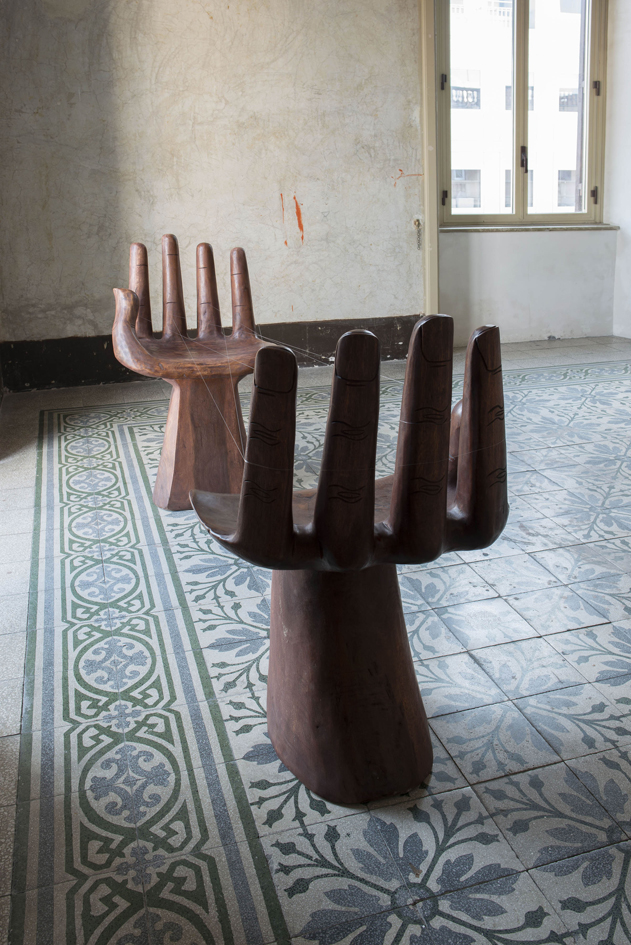
© » KADIST
Adriana Lara
Lara uses things readily at hand to create objects and situations that interrogate the processes of art and the spectrum of roles that art and artists play in society. To these ends, she has used furniture, projections, photographs, clothing, and even people as her materials. A reflection on how the production of meaning itself takes place in the manufacturing of things is embodied in wooden hand chairs, a crafty Indonesian version of the iconic Pedro Friedeberg 1960s Pop design.

© » KADIST
Adriana Martínez
Her work Al final del arcoiris (At the end of the rainbow, 2015) is a bundle of bills from Chile, Venezuela, Brazil, Colombia, Nicaragua, and Costa Rica, arranged by color to form a tight spiraling rainbow held close with a rubber band. Here, Martinez uses these various currencies to gesture towards questions of capital and value, the accumulation of wealth, and regional economies. Beneath the surface of her playful visual propositions, Martinez asks us to consider not only the monetary costs of international goods, but also the real, human consequences of a global economic culture that privileges some and devastates others.

© » KADIST
Adrian Melis Sosa
Shot a few months before the USA and Cuba restored diplomatic relations in 2015, The New Man and My Father looks into the quiet aftermath of one family’s individual experience of the Cuban Revolution (1953-1959). The film brings to the fore a socio-political system made for a country whose successes and failures fell upon the individual men and women who experienced it. In the film, Melis interviews his father about the Cuban Revolution, as well as the more recent re-introduction of capitalism to the island after 60 years of the US-imposed embargo.

© » KADIST
Etel Adnan
Adnan’s paintings are simple images with bold contrasting colors and rich textures. This particular work has an iconic feel and a strong physical presence in spite of its diminutive size. All of her paintings are small but, like Howard Hodgkin’s work, their intensity gains from their diminutive size.
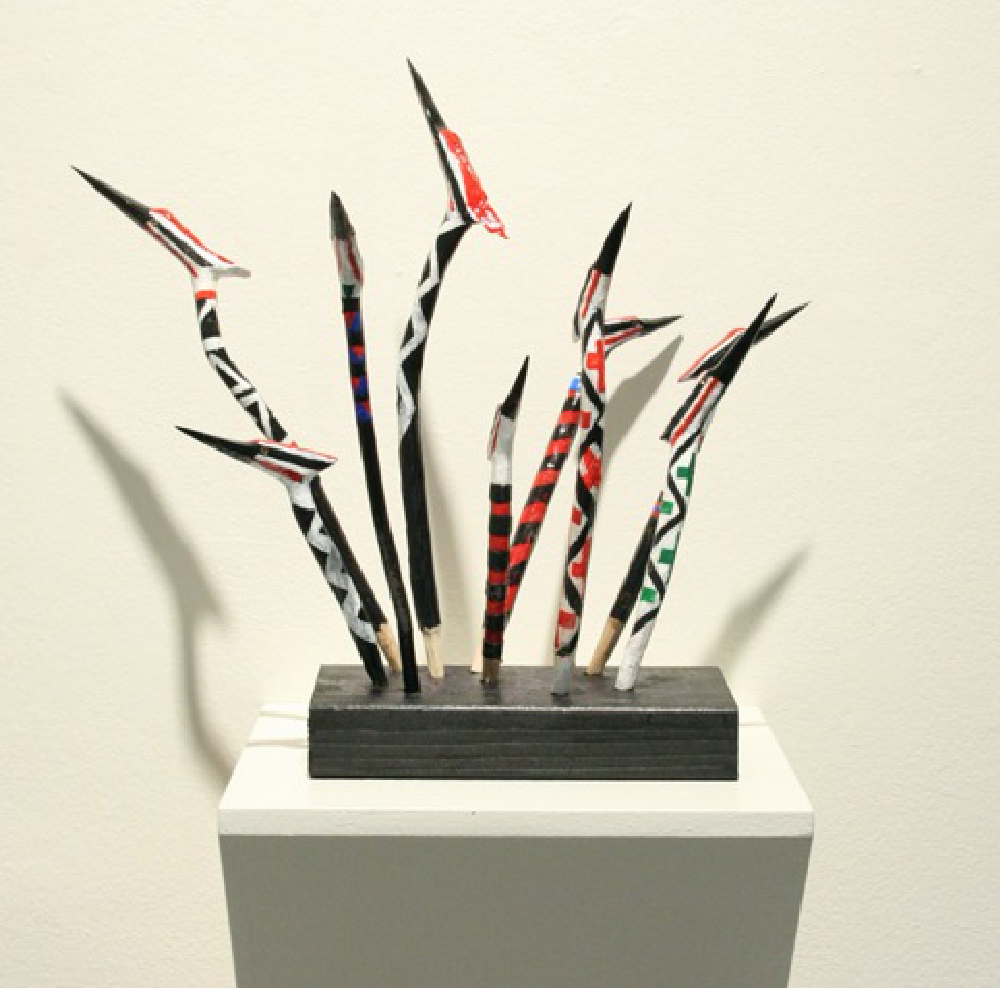
© » KADIST
Brian Tripp
For many years Tripp has been involved in reviving Karuk ceremonies that had been discontinued for decades, he developed his signature abstract style, based in Karuk design, ceremonial regalia forms, and related cultural and political iconography. The two works in the KADIST collection are a continuation of these forms with in the medium of sculpture.
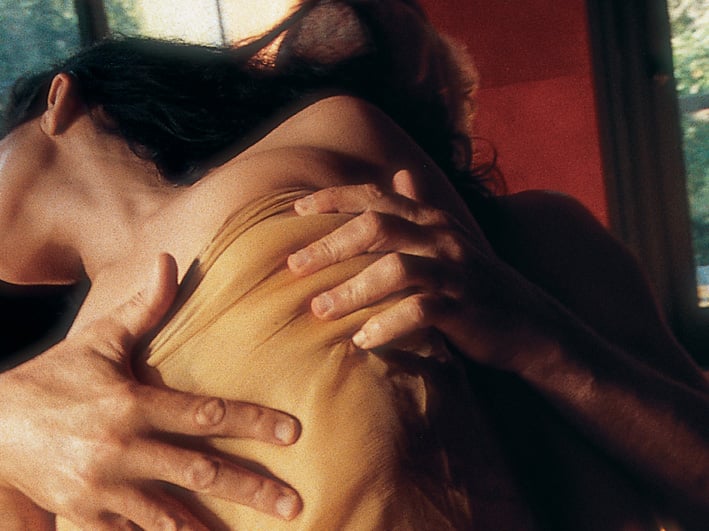
© » KADIST
Daria Martin
In keeping with her mythological proclivity, Minotaur (2009) casts a new light on an old narrative. The film takes the ancient Greek story of the half-man, half-bull as its title subject, but at its core, Minotaur is an homage to pioneering modern dancer and choreographer, Anna Halprin. Along with Trisha Brown, Simone Forti, and Yvonne Rainer, Halprin’s fearless and lifelong dance practice paved the way for the evolution of modern and contemporary dance as we understand it today.

© » KADIST
Brian Bress
Blindseye Arranger (Max) (2013) features a greyscale arrangement of rudimentary shapes layered atop one another like a dense cluster of wood block prints, the juxtaposition of sharp lines and acute angles creating an abstracted field of rectangular and triangulated forms composed as if in a cubist landscape. As the video progresses, however, a disembodied hand begins to move these forms, animating a pictorial frame that was previously still. The hand – ostensibly the “arranger” of the works title – functions as a metonym of the artist’s hand, quite literally bringing a motionless work to life.
![Elevación [Elevation]](https://kadist.org/wp-content/uploads/2022/09/IMG_escena001_3513-scaled.jpg)
© » KADIST
Ana María Millán
Interested in role-play and videogames, Ana María Millán developed workshops with different communities in order to create characters and scenarios for her animations, often in collaboration with a choreographer. Elevación evokes various narratives inspired by the comicstrip Marquetalia, Raíces de la Resistencia (Marquetalia, Roots of the Resistance) (2011). This comic strip is a memoir of the FARC (Revolutionary Armed Forces of Colombia) guerillas written by Jesús Santrich, one of its leaders who, after the 2016 Peace Agreement, rejoined dissident members of the organization in a clandestine guerrilla splinter group in 2019.

© » KADIST
Laura Huertas Millán
La libertad is a “greca” film, a meander film, with no beginning nor end, weaving together fragments of daily life at the Navarro´s, counting threads and time, wondering and wandering around words as emancipation, labor, and freedom (la libertad), the word that most appeared in our conversations. The “greca”, the meander, is the main symbol weaved in the textiles made by the Navarro sisters, from Santo Tomás Jalieza, México. A geometrical form of an endless braid of diamonds, the “greca” represents corn, an entity worshiped by the pre-hispanic civilisations of Mesoamerica.

© » KADIST
Arin Rungjang
246247596248914102516… And then there were none narrates a semi fictional account centered around the ambiguous history of the Democracy Monument in Bangkok, and on the aftermath of the 1973 demonstration of 400,000 people who marched against the military junta from Thammasat University to the monument. Built on archival and oral history, the story interweaves the personal with grand historical narratives to consider the complicated history behind the monument – symbolic of the unrest and violence that led to the Thammasat University massacre on October 6, 1976.

© » KADIST
Brian Jungen
There are several elements to Subject, Silver, Prism . Silver ink is applied to blocks of black foam. A simple stand, reminiscent of cheap furniture, supports a drum constructed from deer hide stretched over plastic cooking bowls and held taut by the hide and twine.

© » KADIST
Daria Martin
Soft Materials is a curious, touching but also disturbing sequence of confrontations between two people: a man and a woman, and machines. Shot in the Artificial Intelligence Laboratory at the University of Zurich, the humans and the machines mirror each other’s actions. It is unclear which party takes the lead.
Brian Tripp
Brian D...
Clare Rojas
- location: San Francisco, California
- year born: 1976
- gender: female
- nationality: American
- home town: Columbus, Ohio
Daria Martin
A number of Daria Martin’s films explore the relationship between humans and machines and make reference to modernist art, whether through the work of the Bauhuas (Schlemmer), Surrealism (Giacometti’s Palace at 4 AM) or American art of the 1960s and 1970s...
Adrian Melis Sosa
Adrian Melis’s work is committed to presenting the range of intensity and nuance of human energy embodied through acts of resistance, resilience, and productivity...
Adrian Villar Rojas
- year born: 1980
- gender: male
- nationality: Argentinean
Reyes Santiago Rojas
Reyes Santiago Rojas works with themes relates to nature, patience and garbage...
Adrien Missika
Adrien Missika (1981, Paris, France) studied and developed his career in Lausanne where he founded 1m3 artspace...
Brian Bress
- location: Los Angeles, California
- year born: 1975
- gender: male
- nationality: American
- home town: Norfolk, Virginia
Adrian Wong
- location: Hong Kong, China
- year born: 1980
- gender: male
- nationality: American
- home town: Chicago, Illinois
Arin Rungjang
Arin Rungjang’s practice is known to revisit historical and political narratives, both major and minor, as a means to consider the past, present and future...
Adriano Costa
Adriano Costa is a Brazilian artist (born in1975) living in Sao Paolo....
Miguel Angel Rojas
For Colombian artist Miguel Ángel Rojas, issues of economic and social inequality in his native country provide fodder to his artistic practice...
Adriana Bustos
Adriana Bustos creates a narrative discourse through installation, video, photography and drawing, in which her reflections on prevailing social, political or religious oppression appear in non-linear interpretations of history...
Uri Aran
Born in 1977 in Jerusalem Lives and works in New York...
Sergio Rojas Chaves
Sergio Rojas Chaves’s work focuses on contemporary depictions of animals and of plants and affective approaches to biology...
Aria Dean
Through art, text, and exhibition making, Aria Dean analyzes the structure and circulation of images and subjectivities in relation to material, cultural histories, and technology...
Brian Jungen
- location: Vancouver, British Columbia
- year born: 1970
- gender: male
- nationality: Canadian
- home town: Ft. Saint John, Canada
Adriana Lara
Adriana Lara is fascinated by how a single thing (an object, a photograph, a song, a text) can be transformed into a work of art...
Laura Rokas
Laura Rokas is a painter, ceramicist, and textile artist...
Etel Adnan and Lynn Marie Kirby
Visual artist, poet, and essayist Etel Adnan writes what must be communicated through language, and paints what cannot...
Etel Adnan
Etel Adnan was born on February 24, 1925 in Beirut and died in Paris on November 14, 2021...
-
2000-2009
Daria Martin
2004Soft Materials is a curious, touching but also disturbing sequence of confrontations between two people: a man and a woman, and machines...
Clare Rojas
2006Rojas’s two pieces in the Kadist Collection— Untitled (four-legged…) and Untitled (Bird’s Eyes) —are representative of her pictorial style which uses bold colorful blocks of paint and female and animal characters...
Adrian Melis Sosa
2008In Cuba, due to the lack of materials, workers of state-owned construction companies must remain at work without doing anything, waiting for the end of the working day...
Clare Rojas
2008Rojas’s two pieces in the Kadist Collection— Untitled (four-legged…) and Untitled (Bird’s Eyes) —are representative of her pictorial style which uses bold colorful blocks of paint and female and animal characters...
Daria Martin
2008In keeping with her mythological proclivity, Minotaur (2009) casts a new light on an old narrative...
-
2010-2019
Adrian Villar Rojas
2010The two drawings in the Kadist Collection are part of a larger series entitled Las Mariposas Eternas (The Eternal Butterflies)...
Etel Adnan
2010Adnan’s paintings are simple images with bold contrasting colors and rich textures...
Brian Tripp
2010For many years Tripp has been involved in reviving Karuk ceremonies that had been discontinued for decades, he developed his signature abstract style, based in Karuk design, ceremonial regalia forms, and related cultural and political iconography...
Brian Tripp
2010For many years Tripp has been involved in reviving Karuk ceremonies that had been discontinued for decades, he developed his signature abstract style, based in Karuk design, ceremonial regalia forms, and related cultural and political iconography...
Miguel Angel Rojas
Drawing & Print
2011(Drawing & Print) In his paper-based work, Medellin-New York , Rojas uses coca leaves and dollar bills to spell out the words of the two cities, tied together through the illicit exchange of materials used to make the word, gesturing towards the uncomfortable reality of the drug trafficking trade and the complicity of both America and Colombia within that economic system....
Adrian Villar Rojas
Drawing & Print
2012(Drawing & Print) Based on historical prophecies and fantasy, the artist creates apocalyptic scenarios that posit an enigmatic world plagued by social, political, and environmental upheaval...
Adrian Wong
2012Untitled (Grate I/II: Shan Mei Playground/ Grand Fortune Mansion) is part of a series drawn from architectural objects that mark the boundary of public and private spaces Wong encountered while strolling in Hong Kong...
Adrien Missika
2013Adrien Missika follows in the footsteps of the Brazilian landscape architect and artist Roberto Burle Marx (1909-1994), a designer of gardens, parks and promenades who introduced modern landscape architecture to Brazil...
Brian Bress
2013Blindseye Arranger (Max) (2013) features a greyscale arrangement of rudimentary shapes layered atop one another like a dense cluster of wood block prints, the juxtaposition of sharp lines and acute angles creating an abstracted field of rectangular and triangulated forms composed as if in a cubist landscape...
Adriano Costa
2014Westminster Agua Viva is made from Westminster City Council(‘s) recycling bin bags, glued together, that the artist has painted and cut or cut and painted...
Adriana Lara
2014Lara uses things readily at hand to create objects and situations that interrogate the processes of art and the spectrum of roles that art and artists play in society...
Adriana Martínez
2015Her 2015 work Orión is a black flag-like cloth with glow-in-the-dark symbols embroidered in the shape of the constellation...
Reyes Santiago Rojas
2015The work Sarta (String) by Reyes Santiago Roja is part of a larger series of works that examine the commercialization of the tobacco plant and its relationship to the meaning and use of tobacco by Native American tribes such as the Mayas, Aztecs, Incas or Tainos, which attributed spiritual qualities to tobacco such as the smoke carrying one’s thoughts and prayers to the sprits...
Adriana Martínez
2015Her work Al final del arcoiris (At the end of the rainbow, 2015) is a bundle of bills from Chile, Venezuela, Brazil, Colombia, Nicaragua, and Costa Rica, arranged by color to form a tight spiraling rainbow held close with a rubber band...
Adrian Melis Sosa
2015Shot a few months before the USA and Cuba restored diplomatic relations in 2015, The New Man and My Father looks into the quiet aftermath of one family’s individual experience of the Cuban Revolution (1953-1959)...
Laura Huertas Millán
2016La libertad is a “greca” film, a meander film, with no beginning nor end, weaving together fragments of daily life at the Navarro´s, counting threads and time, wondering and wandering around words as emancipation, labor, and freedom (la libertad), the word that most appeared in our conversations...
Laura Rokas
2017Like most of Laura Rokas’s hand-stitched works, Once in Two Moons was made while she sat in bed, imbuing the work with a tender sense of domestic intimacy...
Arin Rungjang
2017246247596248914102516… And then there were none narrates a semi fictional account centered around the ambiguous history of the Democracy Monument in Bangkok, and on the aftermath of the 1973 demonstration of 400,000 people who marched against the military junta from Thammasat University to the monument...
Etel Adnan and Lynn Marie Kirby
Drawing & Print
2017(Drawing & Print) In conjunction with KADIST’s 2017 exhibition If Not Apollo, the Breeze , artist and filmmaker Lynn Marie Kirby performed Transmissions , a video and live reading created with longtime collaborator Etel Adnan...
Adriana Bustos
2018El mar y sus múltiples afluentes (The Sea and its Multiple Tributaries) builds on the concept of trafficking that Adriana Bustos has been exploring over the last decade...
Adrían Balseca
2018The project Grabador Fantasma (Phantom Recorder) consists of a communally constructed technological device in Sarayaku ancestral territory...
Sergio Rojas Chaves
2018Más vale pájaro en mano que cien volando (A bird in the hand is worth more than two in the bush) is part of a larger series of pieces developed by Sergio Rojas Chaves in Honduras in 2018 that engages with tourism and in particular amateur-ornithologists that overrun the country in pursuit of the nation’s extreme diversity of bird species...
Adrían Balseca
2019Adrian Balseca’s Suspensión I inverts the logic of the old colonial game, the greasy pole...
Ana María Millán
2019Interested in role-play and videogames, Ana María Millán developed workshops with different communities in order to create characters and scenarios for her animations, often in collaboration with a choreographer...


